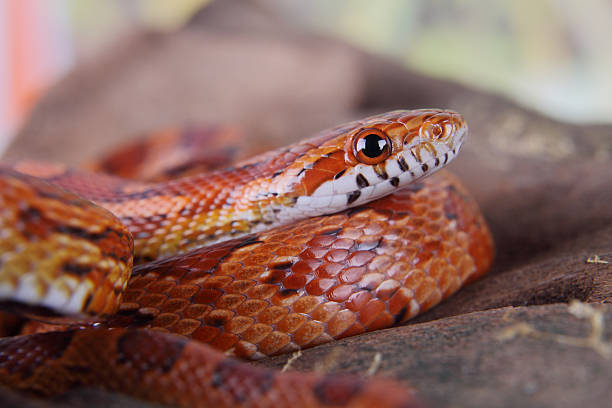Basic Care: Corn Snakes
 Corn snakes (Pantherophis guttatus) are a species of rat snake native to North America. They are found predominantly in forests and woodlands of the southeastern US. These snakes make popular pets as they are docile, non-venomous, and come in a large variety of color and pattern morphs. Corn snakes reach 2-5 feet in length as adults and may live upwards of 20 years in captivity.
Corn snakes (Pantherophis guttatus) are a species of rat snake native to North America. They are found predominantly in forests and woodlands of the southeastern US. These snakes make popular pets as they are docile, non-venomous, and come in a large variety of color and pattern morphs. Corn snakes reach 2-5 feet in length as adults and may live upwards of 20 years in captivity.
Enclosure
While juvenile corn snakes can be kept in smaller containers, an adult corn snake will require at least a 30 gallon terrarium. Snakes are excellent at escaping if allowed to do so, so make sure the enclosure provided is free of any holes and has a mesh or vented lid with a secure locking mechanism. Placing at least two hides in the enclosure, one in the warm end and one in the colder end (see Heating and Lighting below), will allow your snake a place to retreat to if stressed and help them feel more secure in their environment. Placing branches or climbing toys in the enclosure can help provide enrichment and many corn snakes will climb readily if they are provided.
Substrate: Providing a loose substrate will allow your snake to burrow, and can help maintain humidity in the enclosure. Cypress mulch and aspen shavings are appropriate choices, as is shredded newsprint.If you opt to use newsprint, make sure you are monitoring humidity and taking appropriate steps to maintain it, particularly in a place as dry as Arizona (see Water and Humidity below.) Avoid pine or cedar shavings as they can cause respiratory irritation. Sand, corncob, and soil substrates should also be avoided due to the risk of impactions if swallowed.
Heating and Lighting
A heat gradient ranging from 75°F(24°C) on the cool end to 85°F(30°C) on the warm end should be present in the enclosure. At night, this can drop to 65°F-75°F (18-24°C). Using an overhead light as a radiant heat source is preferable over any heating objects such heat mats. Heat mats and heat rocks should never be placed within the enclosure itself, as these can pose a signifcant burn/shock risk. A thermometer placed in both the warm and cold ends of the enclosure will help you ensure the enclosure stays at the appropriate range. During daytime hours a incandescent bulb can provide both heat and light, but at night using a nighttime bulb or heat emitter instead will help maintain a normal day/night cycle.
Diet
Captive corn snakes can happily subsist on a diet of whole rodents. Baby corn snakes should be fed pinkie mice, while adults should be fed appropriately sized adult rodents. These prey items should be no wider than your snake’s head. For both the welfare of the prey animal, and the safety of the corn snake, live prey should be avoided whenever possible and thawed frozen prey should be offered instead. Juvenile corn snakes should be fed twice weekly, whereas adult corn snakes will eat once every 7-10 days.
It is not uncommon for corn snakes to have a temporary decline in appetite during the time they are shedding.
Water and Humidity
Corn snakes have an optimum humidity range of 35-60%. When they are in the process of shedding, maintaining them at the higher end of this range can help encourage a healthy shed. Placing a hygrometer within the enclosure will allow you to monitor the humidity within. Here in Arizona, maintaining appropriate humidity is more difficult due to our dry climate. Providing a large, shallow water dish large enough for your corn snake to completely fit within will help provide humidity as well as provide them with drinking water. The water should be changed daily and the water dish cleaned at least once weekly or if visibly soiled. Placing sphagnum moss in one of your corn snake’s hides can create a “humidity hide” that will provide an area of increased humidity within the enclosure. This moss should be mildly damp when placed and replaced with new, fresh moss when it dries out.



